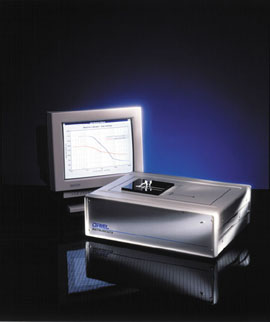Making Sense of Plant Health
Through Small Business Innovation Research (SBIR) funding from NASA's Stennis Space Center, comes a new product that measures the photochemical efficiency of plants. Ciencia, Inc., of East Hartford, Connecticut, created a new device, known as a Portable Photosynthesis Analyzer, or Phase Fluorometer, that provides real-time data about the photochemical efficiency of phytoplankton and other plant forms. The commercial version of this technology is used for photosynthesis research and offers major benefits to the field of life science. This new instrument is the first portable instrument of its kind. Through a license agreement with Ciencia, Oriel Instruments, of Stratford, Connecticut, manufactures and markets the commercial version of the instrument under the name LifeSense.™
LifeSense is a 70 MHz single-frequency fluorometer that offers unrivaled capabilities for fluorescence lifetime sensing and analysis. Fluorescence lifetime refers to the lifetime of the fluorescence process, whereby certain materials emit light at certain wavelengths after absorbing light of shorter wavelengths. The core behind this technology was developed in collaboration with Stennis in an attempt to create a device that could measure the photochemical efficiency of phytoplankton in the oceans.
Presently, NASA uses the Portable Photosynthesis Analyzer for various in situ oceanographic applications. A shipboard version of the instrument was developed for conducting phytoplankton studies. These studies will lay a foundation for comparison, or a ground truth, for data gained from satellite remote sensing of ocean color, human habitability, and biology in space.
The new technology also has other applications. According to Dr. Salvador Fernandez, president of Ciencia, the most significant commercial potential of this technology lies in its instrumental use for photosynthesis research, and in systems for high throughput screening of compounds in agricultural chemical research and drug studies.
LifeSense provides information about all varieties of photosynthetic systems. Photosynthesis research contributes important health assessments about the plant, be it phytoplankton or a higher form of plant life. With its unique sensing capabilities, LifeSense furnishes data regarding the yield of a plant's photochemistry, as well as its levels of photosynthetic activity. The user can then gain an extremely accurate estimate of the plant's chlorophyll biomass, primary production rates, and a general overview of the plant's physiological condition. One of the major LifeSense advantages, is the instrument's ability to model chlorophyll fluorescence and photosynthesis, both of which are related to long, healthy plant lifetimes.
Until now, fluorescence lifetime sensing required expensive equipment. However, with the LifeSense device, the user gets high-resolution, high-sensitivity, rapid measurement time, and broad spectral versatility, all at a relatively low cost.
While NASA benefits from utilizing the portable analyzer on several projects, including the Sea-viewing Wide Field-of-view Sensor (SeaWiFS), the Moderate-resolution Imaging Spectroradiometer (MODIS), and the Space Station Biological Research Program, Ciencia's plans for the future are more down to earth. The company anticipates further potential commercial applications in the areas of precision agriculture, aquaculture, forestry, and food safety.
Recently, Ciencia entered into a licensing and development agreement with HTS BioSystems, of Hopkinton, Massachusetts, to develop further applications of this technology for high throughput screening in drug discovery. Under this agreement, Ciencia will be providing analysis, design, instrumentation, development, systems integration, and prototype fabrication services to HTS.
LifeSense™ is a trademark of Oriel Instruments.

The LifeSense™ instrument is a 70 MHz single-frequency fluorometer that offers superior fluorescence lifetime sensing and analysis capabilities.













